

An Overview of Happenings in the City of Brainerd
for the Years of 1914 and Early 1915
by Ann M. Nelson
The city of Brainerd, in 1914, entertained great expectations for its growth as a bustling business and iron ore mining center, its population in July was estimated, by the United States Census Bureau, to be 8,951—an increase of 1,427 over the census figures of 1910. There were four public grade schools and a high school which graduated thirty-four students on June 1, 1914. According to W. C. Cobb, Superintendent of Schools, the total public school enrollment was about 1,854 scholars with ninety-seven percent attendance and seven cases of corporal punishment.
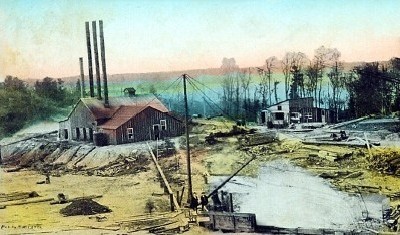 |
| Kennedy Mine, ca. 1914. Source: Postcard |
In 1895 Cuyler Adams and his dog, Una, had discovered iron ore deposits between Deerwood and Brainerd in what became known as the Cuyuna Range lying roughly along a line from Brainerd to Aitkin. In 1904 a shaft was sunk near Deerwood and in 1911 the first iron ore was shipped from the Kennedy Mine at Rabbit Lake near Cuyuna on the Cuyuna Range. Within the city limits of Brainerd, shafts for the Cuyuna-Brainerd Mine were drilled. A concerted effort was made by the city of Brainerd to reap the benefits of this mining activity by attracting more industries.
Judge George W. Holland died in April 1913 and bequeathed two tracts of land to the city of Brainerd. One tract was situated in northeast Brainerd north of the Northern Pacific Railroad shops and the other in southeast Brainerd near the newly platted Cuyuna Range Addition to Brainerd, thus Brainerd became the only city in the United States that owned mineral lands. About July 3, 1914 a corporation to be known as the George W. Holland Company was organized with George D. LaBar, the nephew of Judge Holland, as its president and treasurer; the purpose of this company was to engage in the buying, selling, exploring and mining of mineral lands, etc.
Toward the end of December 1913 the Brainerd-Cuyuna Mining Company, largely financed by Brainerd and Duluth stockholders, sunk a shaft for the Brainerd-Cuyuna Mine, within the city limits of Brainerd, just east of South Sixth Street, near what later became South Seventh Street, and south of what is now Tamarac Street. This mine drained the artesian well of Adam Brown, which, since its discovery in 1892 had been supplying clean, pure water to many of Brainerd’s citizens. By late June 1914 progress had been made in drilling a second shaft. Once the mine began producing, the Northern Pacific Railroad was expected to haul the ore.
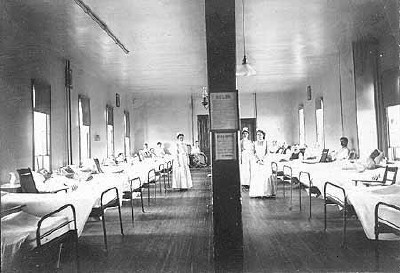 |
| NP Hospital nurses on duty, ca. Unknown. Source: Crow Wing County Historical Society |
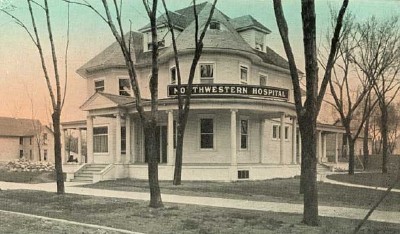 |
| Northwestern Hospital, ca. Unknown. Source: Postcard |
There were two nurses’ training schools in Brainerd, one operated at the Northern Pacific Hospital and one at Northwestern Hospital. On January 26, 1914, six nurses, Bessie Irene Koyl, Glennadean Kerr, Martha Bradley Perry, Florence Emily Miller, Bessie Marie Borgers, Mary Lulu Armstrong and Ruth Muriel Armstrong, graduated from the nurses’ training program of the Northern Pacific Hospital. On May 29 four nurses, Hilma Marie Nygren, Edythe Olive Phillips, Anna Lydia Michaelson and Maybelle Alvenia Schelin graduated from the training program at Northwestern Hospital.
Three major fires occurred in the city in 1914. On March 7 the Mahlum Block, located on the southeast corner of Laurel Street and Broadway [South Eighth Street] containing the Levant Department Store and two apartments, one occupied by the J. P. Early family and a building owned by the O’Brien Mercantile Company, burned in a spectacular fire; damages amounted to about $13,000. On October 23 a fire gutted the interior of the brick two-story, twenty-five by forty foot Brainerd Brewery building located near Boom Lake. There was no fire used in the building since the machinery was run by electricity. The next day the wreck in the interior was still smoking and piles of glass bottles lay melted in heaps. The remains were allowed to cool slowly so as not to crack the heavy cement floor. On December 16 the Bane Block valued at $15,000, located just north of the Citizens State Bank on the west side of South Seventh Street, was burned to the ground. The building was two-stories high and contained the Paris women’s clothing store, a bowling alley, a billiard hall, an attorney’s office, a tailor and two apartments. The Brainerd Journal Press, a newspaper, was located on the second floor; its presses and job equipment crashed through the floors to the basement. The firemen worked in 15 below zero weather, their coats and boots freezing to their bodies.
The council voted unanimously, on March 30, to install a police call system supplied by the Northwestern Telephone Exchange Company. It consisted of four call boxes to be placed in designated places in the city, to which there would later be added gongs connected to the hose [fire] houses. The call boxes had telephones enclosed in metal boxes and were attached to poles. The gongs were placed several feet from the ground and when rung by the telephone operator they could be heard for several blocks. Each policeman was supplied with a special key enabling him to open the box. He would answer the call, talk over the telephone, and was thus in direct communication with the chief. The telephone operator, by pressing the proper button at the telephone office, could call any certain policeman or could ring all gongs simultaneously.
April 15 was a payday and a “bright stream of golden wealth” was disbursed. The organizations making up the largest payroll amounts were the Northern Pacific Railroad, $78,700; Minnesota & International Railway, $15,000; Parker & Topping Foundry, $3,500; City of Brainerd about, $2,000; Water and Light Board, $500; Totaling $99,700.
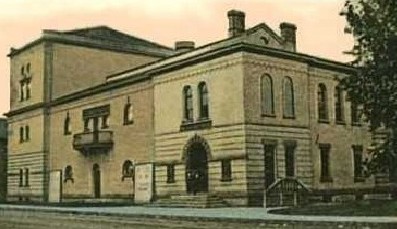 |
| Park Opera House, ca. Unknown Source: Postcard. |
In mid-April contracts were let for improving the Brainerd opera house located on the north side of Front Street between South Sixth Street and South Fifth Street. Decorating went to Frank H. McCaffrey, carpenter work to the White Brothers and plumbing to L. W. Sherlund. Work was to commence on Monday, April 20, and the house was dark until May 18 when it reopened as the Park Theatre with the governor scheduled to make the opening address. Plans for the remodeling included changes in the “ladies retiring room,” the interior decoration of the house, new scenery and a new drop curtain.
The Booster Club of Brainerd, in early March, championed the plan to install an electric sign at the Northern Pacific Railroad depot to advertise Brainerd to the passengers of all trains and to be flashed when conventions and other large gatherings met in the city.
As part of a promotional effort, about May 8, the Brainerd Townsite Company of Duluth, which platted the large addition to Brainerd lying east of the Northern Pacific Railroad shops, began compiling and having drawn a birdseye view map of Brainerd; it was something new and novel and never before attempted. The pictorial representation of Brainerd was intended to be very complete, showing all public buildings, the schools, the Northern Pacific Railroad shops, railway lines, bridges, mines and the new electric sign of the Booster Club. The townsite company had generally advertised Brainerd as “Brainerd, City of Mines” and this slogan was to be placed on the electric sign. The birdseye view map was to be mailed to all sections of the United States and was expected to do much to advertise the townsite company lands and additions as well as the city of Brainerd. The map was published on June 26 graphically showing the city of Brainerd, its various industries and its fine location as a distribution point and center of the Cuyuna Iron Range. It showed the iron ore deposits within Brainerd, developed and undeveloped. Prominently mentioned were the mineral lands bequeathed to the city of Brainerd by the late Judge George W. Holland.
For the first time in Brainerd history, the Raths & Sevolt Film Company took moving pictures of a circus parade and scenes of Brainerd on the morning of June 8, 1914. Under the supervision of E. A. Adams, manager of the Park Theatre, 600 feet of film was taken showing the entire Al. G. Barnes circus parade and the thousands who viewed it. This film along with other proposed moving pictures of all points of interest in and around Brainerd, especially the mining and agricultural developments, was expected to be shown in Minnesota, Iowa, Wisconsin, Michigan, Indiana and Illinois.
George B. Irving, a municipal expert of Chicago, was invited to make a diagnosis of Brainerd’s assets and liabilities as a city. He presented his findings to an audience of Brainerd citizens at Gardner Hall on May 14 laying bare the city’s failings with the diagnosis that Brainerd was too dependent on the Northern Pacific Railroad and the city “too greatly expected the Northern Pacific to clothe and feed it.” The remedy, according to Mr. Irving, was the creation of a Chamber of Commerce which would bring new industries and enthusiasm into the various activities of the city. He went on to say that Evergreen Cemetery formed a prettier city for the dead than was provided for the living.
On May 21 over 120 people attended a meeting called for the purpose of establishing a committee to draft the by-laws and constitution for the newly formed Chamber of Commerce. According to the constitution adopted on May 28 there were twenty-five incorporators; the organization was to commence on July 1, and its period of duration was to be thirty years. On July 1 new officers were to be elected to hold office until the second Wednesday in January 1915. It was hoped the Chamber would be a power for good in the advancement of Brainerd and its various interests.
The annual Northern Pacific Railroad shop picnic was held at Archibald Park in Deerwood, on Saturday, June 20; the company provided two trains of seven coaches each to convey over 2,000 shopmen and their wives and children to the picnic town.
In late June or early July the Northern Pacific Railroad issued the orders necessary to open the Depot Park, situated at the northeast corner of South Sixth and Front Streets, to the public. Two entrances were created on Front Street and one on Sixth and Front. Attorney Franklin E. Ebner donated $100 for the purchase of seats to be placed in the park, thereby making it a real place of rest and comfort for visitors in Brainerd who may have had to wait a short time for the next train.
During the week of July 13 a street carnival for the benefit of the Park Board was held on Main Street [Washington Street] from Fourth Street to Eighth Street; the money derived was to be used for playground equipment throughout the city. Since Main Street was not paved, it was thought not much damage could be inflicted upon it; using Main Street would not interfere with travel, since it was out of the general path of automobiles and therefore offered more safety to pedestrians.
Shortly after the assassination of Archduke Franz Ferdinand on June 28, 1914 in Sarajevo, Bosnia, World War I began. People worried about the war and wondered if the United States would be drawn into it. Money became tight and business began to slow down. All eyes were on Europe wondering what the outcome would be.
The Fill
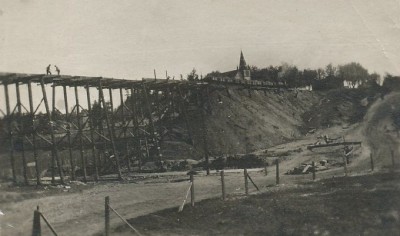 |
| Constructing the Fill, May 1914. Source: Crow Wing County Historical Society |
On February 10, 1914, at the same time bidding was opened on $75,000 worth of bonds to pay for the new city hall and fire hall, bidding was opened on $22,000 worth of bonds to pay for the dirt fill to replace what was known as the Ravine Bridge connecting northeast Brainerd with Brainerd proper. $7,500 worth of these bonds were taken by six local bidders, $2,000 of which were taken by the Brainerd Eagles Club, the city financing the rest. On March 7 bids for the fill were opened and McCullough & Cheney of Minneapolis were declared the winners. Two days later powder was ordered for blasting the frozen ground in preparation for the city to build the culvert under the fill; City Engineer Peacock was authorized to pay a minimum wage of twenty-five cents an hour for labor in building it. On the same day a steam shovel and two steam-powered dinky engines arrived. W. E. McCullough, member of the firm of McCullough & Cheney, was in the city in late March to look over the ground and examine the work the city was doing putting in the culvert. He said his firm was ready to go on the fill as soon as the culvert had aged sufficiently to stand its weight. About forty men were employed in the filling operations, including a foreman on the dump, two men for track repairing, four in the pit, three engineers, a crane man, shovel man and night watchman. Over a mile, about 6,300 feet, of narrow gauge tracks were laid in early May for the twenty dump cars hauling gravel to the site. The tracks started at the hill on the Holland land, circumvented the swamp on its north end, extended down Pine Street [“D” Street] to Fifth Avenue, then to Kindred [Washington Street] and on Kindred to the end point on the bridge. A switch was located at Forsythe [“C” Street] and Fifth Avenue; a standpipe was situated at the corner of Farrar [“B” Street] and Fifth, this supplied water for the two locomotives. In order to sustain the weight of the cars being run out on it and dumped the old bridge required reinforcement. A couple of weeks later the huge steam shovel was chewing its way into the Holland hill; the massive jaws of the steam shovel dipper tore away the bank, grabbed a mouthful of soil, rocks and stumps and dropped them into one of a waiting string of dump cars. A second dipper load of dirt filled the car. A signal was given by a man on the bank; the miniature engine answered with a tug and moved the next car in line for its two dipper loads. Two industrious pint-sized dinky locomotives hustled through the streets each pushing ten cars of dirt, dumping them and then scurrying back with the empties for another load. Late in June the fill was completed.
Note: Dinky/dinkey engines/locomotives were small steam-powered locomotives primarily used in mining operations.
Parker Bandstand
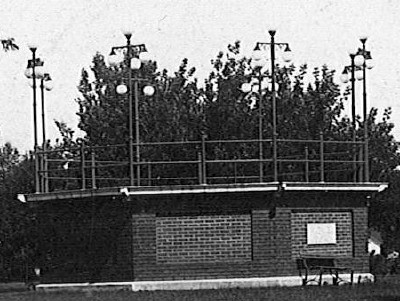 |
| Parker Bandstand, ca. 1914 Source: Crow Wing County Historical Society. |
In August 1914 the Charles N. Parker family offered to donate a bandstand to be erected in Gregory Park. The bandstand was to be a memorial to the family patriarch, Charles N. Parker, who came to Brainerd in 1872 to start the Parker & Topping Foundry, which provided metal castings for the Northern Pacific Railroad. During the ensuing years, Charles Parker was responsible for, among other things, erecting the Parker Block which first contained his Northern Pacific Bank, later becoming the Citizens State Bank on the northwest corner of South Seventh and Laurel Streets as well as for building the Brainerd Electric Street Railway which opened for business on May 9, 1893.
The bandstand was designed and built in the shape of an octagon by the White Brothers of Brainerd. It was composed of a concrete foundation and a cement floor in the basement with stairs leading to the main floor which was built of Washington fir in order to ensure proper acoustics. The walls were of red pressed brick selected by Fred S. Parker in honor of his father who chose that color and type of brick for his bank building. An ornamental railing surrounded the main floor and the lighting facilities were the best, consisting of eight groups of cluster lights, twenty-four lights in all. In Gregory Park the bandstand was accorded a position on a slight knoll, the highest spot in the park. When the city band played at the dedication ceremonies, it was noted the tunes were heard in every section of the park, thus demonstrating that the selected site was a most appropriate one. The soft tones of the band were distinctly heard within a radius of four blocks from the park. The bandstand cost in the neighborhood of $868 and was dedicated on October 11, 1914.
City Hall, Jail and Fire Hall
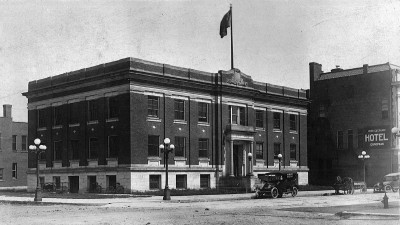 |
| Newly built City Hall, ca. 1914. Source: Crow Wing County Historical Society |
Bidding was opened on February 10, 1914 for $75,000 worth of bonds to finance the building of a new city hall, jail and fire hall. City Hall architect C. Howard Parsons, of architects Alden & Harris, Minneapolis, wrote that the plans for the city hall and jail were about completed and asked for a council meeting to consider them. On March 16 eighty car loads of gravel were ordered to be delivered on the Minnesota & International Railroad from Ahrens’ Hill to the site. It was later recommended that a conveyor be installed into which the men could shovel and thus load the cars at the Ahrens’ Hill pit.
Architect Parsons presented his plans for the new building on April 27 and it was expected that the city would advertise for bids on May 11. The plans were on exhibit in the City Clerk’s Office and the public was invited to view them and make comments. On August 17 the general building contract was awarded to Hodgin Construction Company of St. Paul. Jail cells, corridors, doors, vault doors, etc., went to the Diebold Safe Company of St. Paul, at $4,000. The electrical work was given to Nemis & Nemis of St. Paul, at $718. The plumbing and heating contract was let to Slipp-Gruenhagen Company of Brainerd, at $3,673 for the plumbing and $3,811 for the heating plant. The plumbing and heating supplies to be used were to be purchased from the Crane & Ordway Company of St. Paul and approved by the architect. A bill of $1,600 was awarded the architect for the drawing of the plans and other work incurred in the preparations for the bids. The building would be of dark pressed brick variegated in color and trimmed with light granite and dark stone. Excavation for the main structure was begun on August 25 and was to be five feet deep and about 54 by 90 feet in size. Including the jail, the basement measured about 140 by 150 feet.
The plasterers, George Thill & Sons of St. Paul, were putting on the finish coat on February 12, 1915. Molded beam ceilings were created, the only work of the kind resembling it was in the post office which was built in 1910. The council chambers, situated at the east side of the city hall, were elaborately decorated with a ceiling of four full beams and two half beams. The cornice molding consisted of six members and molding plaster, plaster of Paris and stucco were used in its composition. About this time the jail was ready for the white coat. By Monday, February 15, the last of the plastering was underway in the fire hall and all plastering was finished by about Thursday, February 25.
 |
| Newly built Fire Hall, ca.1914. Source: Crow Wing County Historical Society |
Without ceremony, the new city hall was occupied on Thursday, April 29, 1915. City Clerk Anton Mahlum, with his employees, worked heroically and were the first to be established in the new space, occupying the southwest corner of the building on the second floor. City Engineer Peacock’s office was next door. The municipal court moved to its new quarters on the second floor. The first case, regarding a deal on a horse, to be tried in the new court room was that of Ole Lawson vs. Frank Veillette; W. H. Crowell was the attorney for the plaintiff and M. E. Ryan the attorney for the defense. The plaintiff rested his case and it was dismissed by Judge J. H. Warner. The council chambers, said to be light and airy, offering comfortable space to all who wished to hear the proceedings, were occupied Thursday evening by the council assembled in a special meeting. At the Water and Light Board offices, situated on the main floor in the southwest corner of the building, William Nelson, secretary, installed the equipment. The Hotel Antlers was one of the first to pay its water and light bill. The Water and Light Board also had the southwest corner of the ground floor for its workshop and additional rooms for storage. The farmers’ restroom was also located in the basement. The new city jail was unoccupied, no one seemed to be rushing for the distinction of being the first to get a cell.
The fire hall was to be occupied as soon as cement work near the entrance had been completed. The fire truck was on hand and ready to be run into its new quarters. Of the $75,000 in bonds voted to build the city hall, jail and fire hall, about $4,500 was left in the building fund.
New City Fire Truck
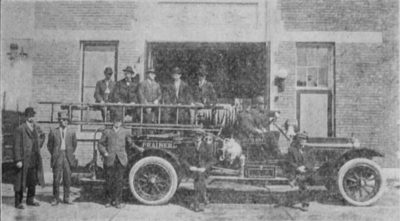 |
| Newly purchased Fire Truck, 14 May 1915. Source: Brainerd Daily Dispatch |
The White fire truck, purchased by the city, was given a trial spin on the afternoon of April 8, 1915 by the demonstrator, Joseph Cornelius, of Cleveland, Ohio. The truck made a straight shot up North Sixth Street and at about a speed of forty-five miles an hour flew around the corner of Kingwood. The passengers gasped, expecting to be hurled out with the ladders and other paraphernalia on top of them. Before they got another gasp, the truck let out another link of speed and was shooting down the straight-away path and onto the sand hills near the river bank. It was raced out to northeast Brainerd, over the bridge fill, through back alleys, out on Oak Street, turned around in sand and given every kind of a demonstration in Brainerd’s streets and alleys to show what the truck could do. Tears streamed from the eyes of all the occupants of the truck, as no one was wearing goggles. The truck, to be housed in the new fire hall, was equipped with a large searchlight illuminated by electricity and provided with all kinds of fire fighting apparatus, ladders and lanterns, etc.
A Few Other Items of Interest Occurring in 1914 Brainerd
•On March 23 W. E. Lively, the local dealer handling Harley-Davidson Motorcycles, took delivery of one of the largest shipments of motorcycles ever received in Brainerd; thirteen twin two-speed machines, a single and three sidecar machines were handed over.
•On March 27 the Bachelor Maids, a group of local women, scored a distinct hit with their entertainment at the Grand Theater, the proceeds of which were used for charitable purposes. Two performances were given and each drew a crowded house.
•On April 14 it was expected hoboes would be giving Brainerd a wide berth during the spring since the city lockup housed a virulent case of scarlet fever.
•On July 17 the city’s huge cement mixer, feeding on a mixed diet of gravel from Ahrens’ Hill, water and cement, provided concrete pavement on Kingwood Street from North Broadway to North Fifth Street.
•On August 18 an ordinance licensing the use of streets, avenues and alleys by vehicles for the transportation of persons and properties received its final reading, creating a license fee of $1 for one horse vehicles, $2 for two horses, $4 for four horses and $5 for more than four horses, $5 for an automobile and $3 for a motorcycle; licenses to run for one year from date of issue.
•By October 2 eighty licenses had been issued for motor vehicles in Brainerd.
•About December 25 the first municipal ice skating rink ever undertaken in this part of the state was opened. It was 200 by 400 feet and located in the large vacant lot between the fill and the Northern Pacific tracks on the west side of the large sewer. A sizable arc light was located in the center of the rink to illuminate the entire surface while seats and benches were to be provided as soon as practicable.
- City Hall; Newly built City Hall, ca. 1914.; CWCHS; 400x225
- Fill; Constructing the Fill, May 1914.; CWCHS; 400x236
- Fire Hall; Newly built Fire Hall, ca.1914.; CWCHS; 400x252
- Fire Truck; Newly purchased Fire Truck, 14 May 1915.; Brainerd Daily Dispatch; 400x221
- Kennedy Mine; Kennedy Mine, ca. 1914.; Postcard; 400x235
- Northwestern Hospital; Northwestern Hospital, ca. Unknown.; Postcard; 400x234
- NP Hospital Nurses; NP Hospital nurses on duty, ca. Unknown.; CWCHS; 400x273
- Park Opera House; Park Opera House, ca. Unknown; Postcard.; 400x231
- Parker Bandstand; Parker Bandstand, ca. 1914; CWCHS.; 400x301
Thanks to the following individuals who made this website possible:
Crow Wing County Historical Society
Brian Marsh
Pam Nelson
John Van Essen
Researched and Compiled by Ann M. Nelson. Last Update: 20 January 2018
